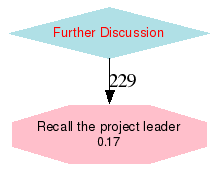General Resolution: Recall the project leader
- Time Line
- Proposer
- Seconds
- Minimum Discussion
- Text
- Quorum
- Data and Statistics
- Majority Requirement
- Outcome
Time Line
| Proposal and amendment | Wednesday, 20th September, 2006 | Thursday, 21st September, 2006 |
|---|---|---|
| Discussion Period: | Thursday, 21st September, 2006 | Saturday, 7th October, 2006 |
| Voting Period | Sunday, 8th October, 00:00:00 UTC, 2006 | Sunday, 15th October, 00:00:00 UTC, 2006 |
Proposer
Denis Barbier [barbier@debian.org]
Seconds
- Clint Adams [schizo@debian.org]
- Julien Blache [jblache@debian.org]
- Marc Dequènes [duck@debian.org]
- Pierre Habouzit [madcoder@debian.org]
- Aurélien Jarno [aurel32@debian.org]
- MJ Ray [mjr@debian.org]
- Martin Schulze [joey@debian.org]
- Anthony Towns [ajt@debian.org]
Minimum Discussion
Denis Barbier and Loïc Minier, per delegation of the Debian Project Leader, vary the discussion and voting periods by one week. The voting period is then one week long only.
Text
Recall the Debian Project Leader, as allowed by the Constitution (section 4.1.1).
Quorum
With the current list of voting developers, we have:
Current Developer Count = 1000
Q ( sqrt(#devel) / 2 ) = 15.8113883008419
K min(5, Q ) = 5
Quorum (3 x Q ) = 47.4341649025257
Quorum
- Option1 Reached quorum: 48 > 47.4341649025257
Data and Statistics
For this GR, as always statistics shall be gathered about ballots received and acknowledgements sent periodically during the voting period. Additionally, the list of voters would be made publicly available. Also, the tally sheet may also be viewed after to voting is done (Note that while the vote is in progress it is a dummy tally sheet).
Majority Requirement
All the amendments need simple majority
Majority
- Dropping Option1 because of Majority. 0.173 (48/277) <= 1
Outcome
In the graph above, any pink colored nodes imply that the option did not pass majority, the Blue is the winner. The Octagon is used for the options that did not beat the default.
- Option 1 "Recall the project leader"
- Option 2 "Further Discussion"
In the following table, tally[row x][col y] represents the votes that option x received over option y. A more detailed explanation of the beat matrix may help in understanding the table. For understanding the Condorcet method, the Wikipedia entry is fairly informative.
| Option | ||
|---|---|---|
| 1 | 2 | |
| Option 1 | 48 | |
| Option 2 | 277 | |
Looking at row 2, column 1, Further Discussion
received 277 votes over Recall the project leader
Looking at row 1, column 2, Recall the project leader
received 48 votes over Further Discussion.
Pair-wise defeats
The Schwartz Set contains
- Option 2 "Further Discussion"
The winner
- Option 2 "Further Discussion"
Debian uses the Condorcet method for voting.
Simplistically, plain Condorcets method
can be stated like so :
Consider all possible two-way races between candidates.
The Condorcet winner, if there is one, is the one
candidate who can beat each other candidate in a two-way
race with that candidate.
The problem is that in complex elections, there may well
be a circular relationship in which A beats B, B beats C,
and C beats A. Most of the variations on Condorcet use
various means of resolving the tie. See
Cloneproof Schwartz Sequential Dropping
for details. Debian's variation is spelled out in the
constitution,
specifically, A.6.
Manoj Srivastava

